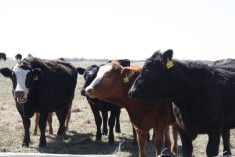This cattle market information is selected from the weekly report from Canfax, a division of the Canadian Cattlemen’s Association. More market information, analysis and statistics are available by becoming a Canfax subscriber by calling 403-275-5110 or at www.canfax.ca.
Fed cattle set record
The weekly Canfax weighted average steer price was $196.78 per hundredweight, while heifers averaged $194.01, both new record highs.
Western Canadian fed cattle slaughter for the weeks ending Feb. 28 and March 7 were about 32,000 head, but slaughter was down the following week.
Read Also

Volatile temperatures expected for this winter
DTN is forecasting a lot of temperature variability in the Canadian Prairies this winter. Precipitation should be close to average.
Some cash cattle were reallocated last week to meet contract obligations and others were committed on a formula price arrangement, but negotiated sale volumes were adequate to establish a weighted average steer and heifer price.
U.S. buyers were active in the Canadian market, and bids strengthened. These sales worked back to the mid to upper C$190s, depending on freight and dressing percent. Cattle sold to the United States would be lifted within two weeks, while local buyers are scheduling cattle for roughly three week delivery.
It was the first time this year that Canadian fed exports to the U.S. exceeded 6,000 head.
Western Canadian fed slaughter will struggle to exceed 30,000 head over the next two weeks.
Alberta fed cash-to-futures basis closed the week at -$1.49.
Basis levels usually improve into April.
Cows at records
D1, D2 cows ranged $138-$152 per cwt. to average $145.33, while D3s ranged $120-$138 to average $128.10
Grain fed cows fetched premium prices.
Rail grade cows were $277-$282
Slaughter bulls set new highs with a weighted average of $157.22.
Weekly western Canadian non-fed slaughter to March 14 fell to 5,273 head. Export trucks are being reallocated to accommodate increased feeder and fed cattle shipments, but non-fed exports will likely increase in coming weeks.
Seasonal demand for hamburger should maintain strong non-fed prices.
Feeder prices soar
Strong demand for steer calves stretched the Alberta calf-feeder spread to a record level.
Steer calf prices rallied $3-$5.50, and heifer calves 500-700 pounds surged $4.50.
Feeders heavier than 700 lb. generally rose $1.50-$2.50.
A few special feeder sales increased the week’s sale volume to the largest this year.
Alberta auction volume rose six percent to 40,299 head, which was one percent larger than last year. That was likely the seasonal peak for volume.
Weekly feeder exports to the U.S. to March 7 rose eight percent to 12,277 head. Feeder exports this year are up 11 percent to 89,764 head.
Many of the feeders offered during the first quarter of 2015 are going to auction for a second time. Last fall, buyers put them in a backgrounding program.
There will continue to be strong competition for the small number of feeders.
U.S. beef mixed
There was little trade in the U.S. but dressed sales in Iowa were steady to $3 stronger, while trade in the American South was $3 higher on a live basis.
American packers are cutting hours as they try to mend negative processing margins. The weekly cattle slaughter was 518,000 head, down 1.2 percent from the previous week and 10.6 percent lower than the same time last year.
Choice cutout last week rose 63 cents to US246.61 per cwt., while Select was down $1 at $244.79.
Canadian cut-out values for the week ending March 7 rose C$3-$4 from the previous week with AAA at $305.68 and AA at $303.66.
AAA prices are now 28 percent higher than a year ago, and AA is 29 percent higher.














